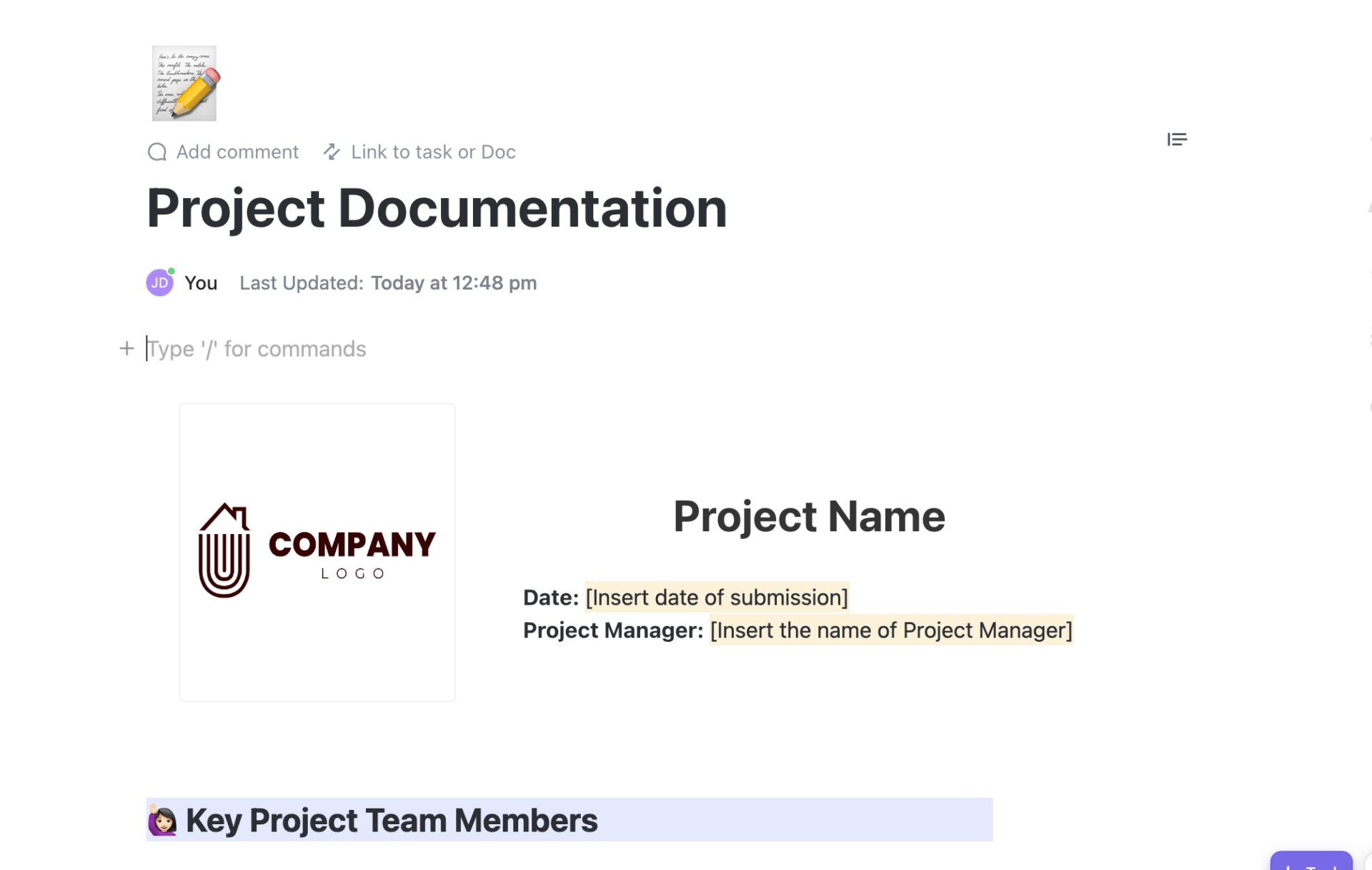
High-quality project documentation has long-term value. It not only helps to ensure the success of the project, but it also serves as a reference for future projects and initiatives!
At its core, project documentation is the pulse of any project. It connects everything needed to run the project successfully.
Documentation must be extensive enough so development can progress. But flexible enough so modifications or adjustments can be made in response to different situations.
Let’s take a closer look at the primary types of documentation, along with others typically buried within inboxes that should be organized into project management software. ⚒️
If you need a fast-track solution to start documenting your projects the right way, get your team into ClickUp’s Project Documentation Template! Collaborate in real-time or async and even assign comments within the Doc to keep communication in one place.

Let’s get started!
Writing Project Documentation: Time-Saving Tips and TemplatesSummarize this article with AI ClickUp Brain not only saves you precious time by instantly summarizing articles, it also leverages AI to connect your tasks, docs, people, and more, streamlining your workflow like never before. Summarize article
Summarize this article for me pleaseProject documentation is any type of written material that describes the details of the steps taken throughout a project’s life cycle. This includes the project scope, planning, development, change control, assessments, and quality assurance reports. Sharing information makes sure everyone has the right context to get their work done efficiently. Good documentation helps with collaboration, communication, training, and problem-solving throughout the lifecycle of a project.
More importantly, project documentation plays an important role in the success of any project by providing details for informed decision-making.
Summarize this article with AI ClickUp Brain not only saves you precious time by instantly summarizing articles, it also leverages AI to connect your tasks, docs, people, and more, streamlining your workflow like never before. Summarize article
Summarize this article for me pleaseDocumentation connects people with the right content at the right time. Having the proper project documents is key to successfully managing a project from start to finish. A variety of documents, such as diagrams, timelines, policies, reports, meeting minutes, and project plans come together to provide a comprehensive overview. 🌐 Plus, maintaining accurate documents is required for reviews and audits, helping us track what’s been accomplished and keeping everyone accountable for their part!
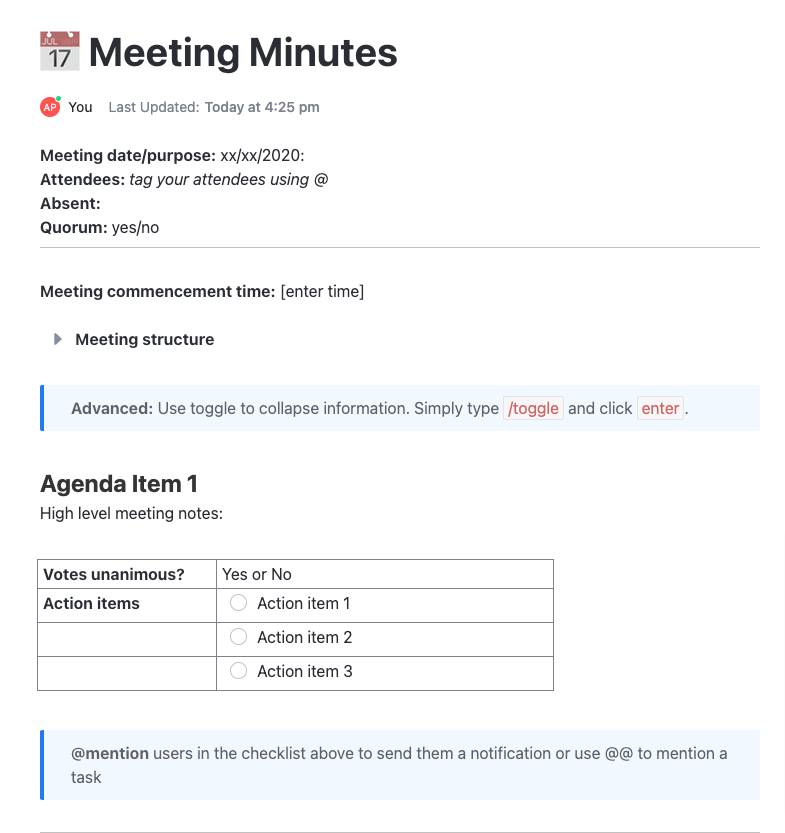
Owner: Primary stakeholder, sponsor
Contributors: As needed A project proposal document outlines the objectives and scope of a proposed project. It’s typically written by the project’s stakeholders in order to secure approval and necessary funding for the project. The document typically includes an executive summary, background information, objectives or goals, proposed methods, projected timeline, budget, and risks. After approval, the project manager uses the document to write the project charter.

Documenting the necessary stakeholders ahead of time will help prevent scope creep later in the project!
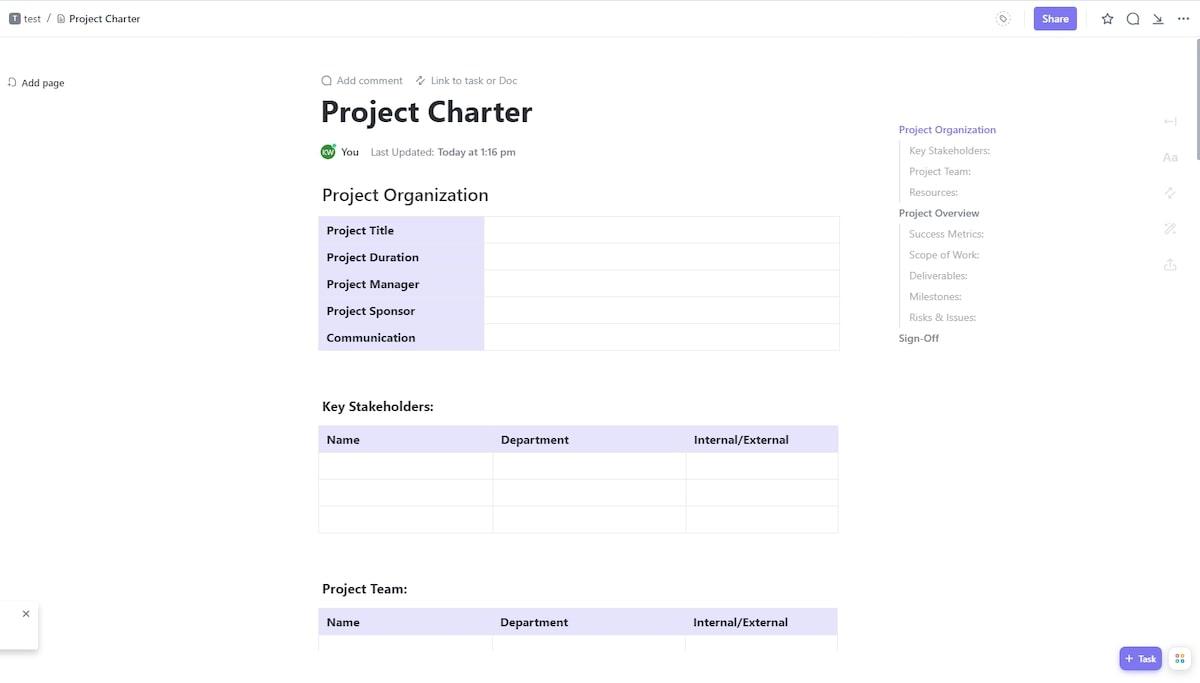
Owner: Project manager
Contributors: Department leads
A scope of work document is a detailed description of the work that needs to be done on a project. It outlines the objectives, tasks, deliverables, timeline, cost estimate, dependencies, and any other relevant information to guide your project team to success.
Additionally, the project plan should discuss any potential risks or challenges that could happen during the course of the project, and propose solutions for handling them.

Owner: Project manager
Contributors: All team members as needed
A project status report covers the current state of the project written for key stakeholders and project leaders. Status reports are typically sent on a weekly basis by the project manager, who condenses large amounts of data and task progress.
It generally shouldn’t take more than 5 minutes to read and includes these key information:
Owner: Project manager
Contributors: Stakeholders
A change management plan outlines the processes, procedures, and resources required to apply changes to a project’s deliverables, team members, or strategy. It helps maintain control of the scope and ensures all stakeholders are fully aware of changes being implemented.
The plan typically includes:
Learn more about how project change management plans in ClickUp help teams stay on track!
Owner: Project manager
Contributors: As needed
A project post-mortem is a reflection document capturing key outcomes and lessons learned from a project. Post mortems should include an assessment of the project’s overall effectiveness, along with an analysis of any challenges and the tools used for project completion.
The project manager creates the retrospective document, and all project team members contribute their feedback and questions. This can help the team become more aware of blind spots, identify areas of improvement, call out specific project successes, and develop better methods of problem-solving!
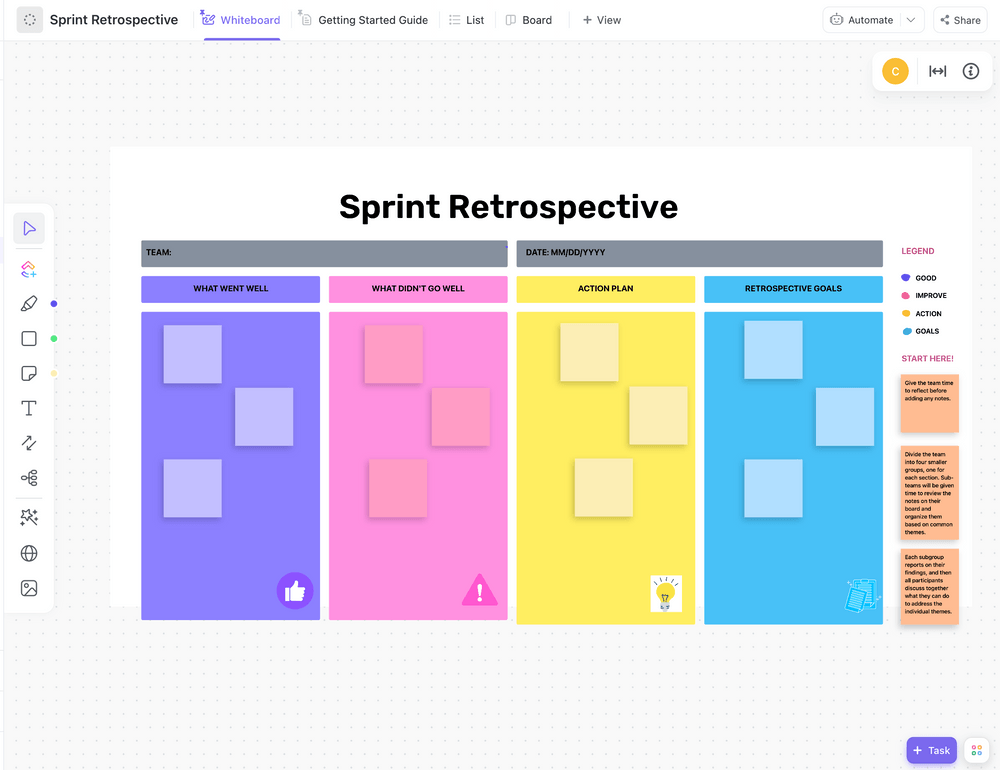
Summarize this article with AI ClickUp Brain not only saves you precious time by instantly summarizing articles, it also leverages AI to connect your tasks, docs, people, and more, streamlining your workflow like never before. Summarize article
Summarize this article for me pleaseKeeping track of documentation takes a considerable amount of effort if you’re updating multiple channels of communication. And sometimes you’re sending the same information to different channels. Here are the best practices to create project documentation:
If a new marketing team member needs to get up to speed on a specific project, it wouldn’t make sense to digitally toss them into a group Slack channel to put pieces of information together. Organize information with the audience in mind. ClickUp Docs are the most efficient tools to connect tasks to documentation within a few clicks. And it’s easy to set up! Divide the documentation by the types we learned earlier—proposal, charter, plan, and so on—into separate subpages. 📄 From there, you can take your team’s Doc experience even further with page customization and collaboration tools. If you have other project documentation like Google Sheets and PDFs, embed these resources into the Doc for quick access! For seamless integration of project documentation, make the most of ClickUp’s AI Writing Assistant. ClickUp AI can generate drafts based on your notes, suggest content improvements, and even help in maintaining the documentation up-to-date. By centralizing and streamlining the documentation process with a sophisticated AI assistant, your team can focus on more strategic tasks while keeping everyone informed and aligned with the project objectives. Working together on documentation allows for different perspectives to be included, which can increase engagement and alignment.
Learn About Docs Check out the top document collaboration software!Documenting a project early and often is important because it guides the work with the right context. Project members can avoid wasting time trying to figure out why certain decisions were made or how something was supposed to work. And if you’ve ever waited until the last minute to document your time, tasks, and statuses, you know firsthand the mental energy it takes to get it done! (We’ve all been there.) 🙋 Bonus: Team charter templates!
Project templates are useful tools for teams to quickly and efficiently start up new projects. They provide a standard process to follow and a reusable framework for the project, taking out the time and effort of setting up the project from scratch. However, as time goes on, industry standards, customer needs, and internal procedures are constantly changing. This means that project templates need to be updated regularly to ensure they remain efficient and relevant. The result? Teams can maintain their workflow and quickly launch into a project with minimal setup time!
Adding visuals to project documentation helps stakeholders and team members understand the content by making it more engaging, easier to comprehend, and more memorable. Visuals have the power to convey a point quickly, allowing for more efficient communication of complex topics. They also help to break up large blocks of text, making the content more readable. Visuals can be used to explain relationships between different pieces of data and elements, creating a deeper understanding of the context. 📊
Summarize this article with AI ClickUp Brain not only saves you precious time by instantly summarizing articles, it also leverages AI to connect your tasks, docs, people, and more, streamlining your workflow like never before. Summarize article
Summarize this article for me pleaseProject documentation is an essential part of any project, providing not only a record of the project’s progress but also important information for future decision-making and planning. An indispensable archive of all the decisions, changes, and discussions associated with a given project allows teams to have past reference points to draw upon, making it easier to track progress, address technical issues and avoid costly mistakes in the future. 🔮
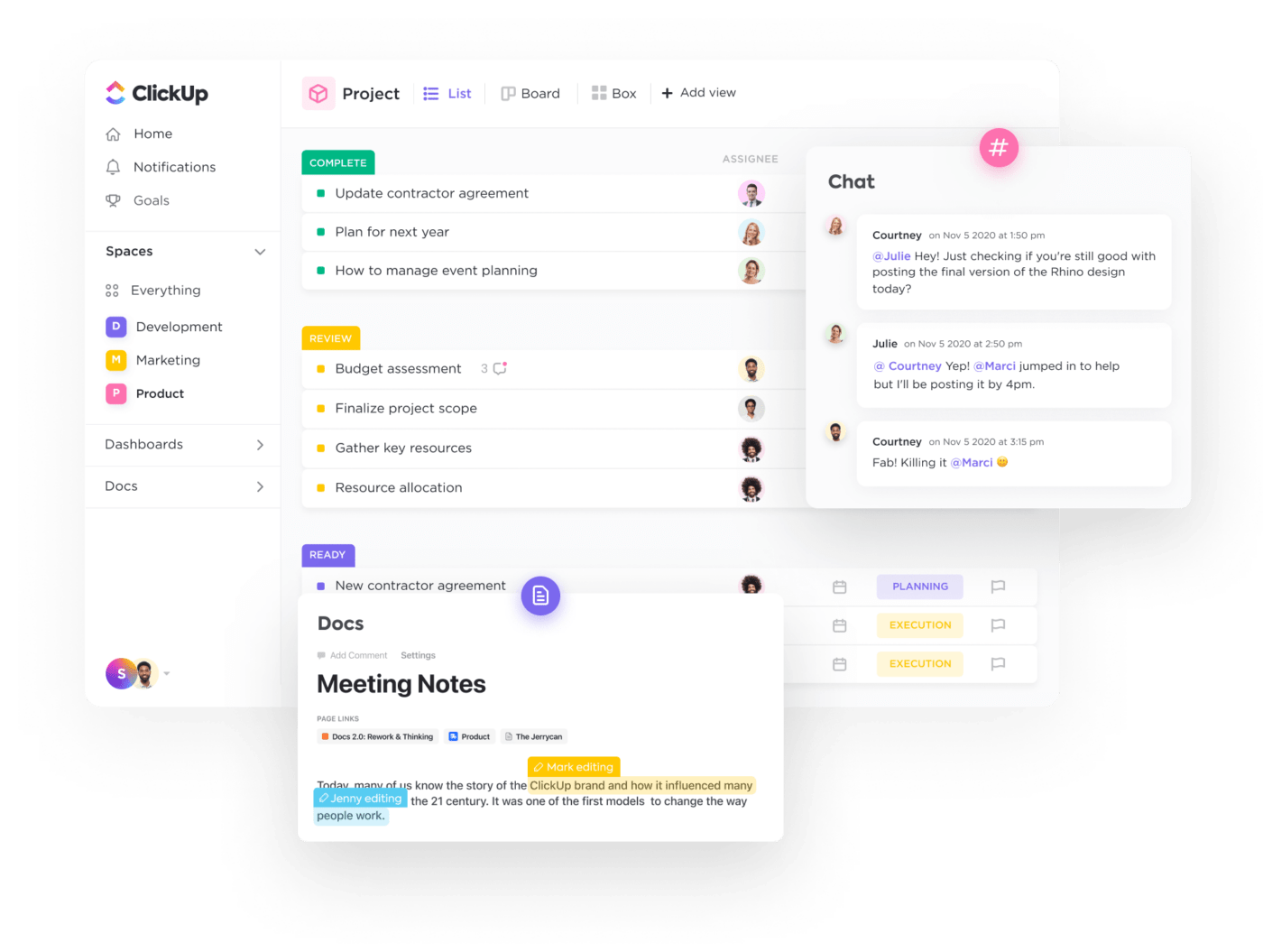
Summarize this article with AI ClickUp Brain not only saves you precious time by instantly summarizing articles, it also leverages AI to connect your tasks, docs, people, and more, streamlining your workflow like never before. Summarize article
Summarize this article for me pleaseWhen it comes to project documentation, the right software can make a world of difference. However, not all tools are built the same way. Here are some steps to help you choose the best one for your needs: 1. Determine Your Needs: Before you can effectively choose a project documentation tool, you first need to determine what you require from it. What scale of projects will you be working on? What kind of documents will you need to create and manage? Will you need real-time collaboration features? 2. Consider Your Budget: The cost of software can vary greatly. You would want to find a tool that offers all the features you need within your budget. Additionally, consider the flexibility of the payment plan. Is it a monthly or annual subscription? What happens if you need to switch plans or cancel your subscription? 3. Assess User-Friendliness: The last thing you want is a system so complex that it hinders productivity. User-friendliness is a critical factor to consider. A steep learning curve can slow down work and frustrate teams. Choose a tool that’s easy to navigate and intuitive to use. 4. Check out Collaboration & Sharing Features: If your team often works collaboratively on projects, it’s vital that your documentation software has real-time collaboration and sharing features. It should be easy for team members to share, review, and comment on documents within the platform. 5. Integration with Other Tools: Even the best project documentation software may not completely replace all the other tools your team uses. Therefore, it’s crucial to ensure that the software you choose can easily integrate with your existing systems like management tools, communication platforms, or file storage services. 6. Technical Support & Customer Service: Quality customer support can be invaluable when you encounter an issue. Ensure your chosen software provider offers reliable, efficient, and robust customer service and technical support. 7. Flexibility and Scalability: Your project documentation software should be able to grow with your business. Ensure that it’s flexible enough to accommodate your future needs and scalable enough to handle a larger volume of projects or more extensive team collaboration. 8. Security and Data Protection: When you’re dealing with project documentation, security is paramount. Make sure that the tool you choose places a high priority on data protection and privacy. 9. Test the Software: Most software providers offer free trials or demos. Take advantage of these to familiarize yourself with the software before making a final decision. You’ll have a better sense of whether the tool meets your requirements and if it’s easy to use for your team. 10. Read Reviews: Lastly, browse online reviews and testimonials from other users to gain insights into the software’s strengths and weaknesses. Reading about others’ experiences can help guide your decision and set realistic expectations. By paying attention to these tips and considering your project needs and budget, you’ll be better equipped to find the right project documentation software. Remember, the best tool for you is one that streamlines your workflow, enhances collaboration, improves efficiency, and fits seamlessly into your project management process.
Summarize this article with AI ClickUp Brain not only saves you precious time by instantly summarizing articles, it also leverages AI to connect your tasks, docs, people, and more, streamlining your workflow like never before. Summarize article
Summarize this article for me pleaseQuestions? Comments? Visit our Help Center for support.